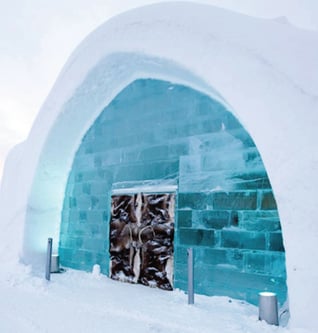Yngve Berqvist used his skills and contacts to create his unique ICEHOTEL. Stuart Read and Saras Sarasvathy report.
After five years working for a mining company in Kiruna, Sweden, Yngve Bergqvist realised that he did not want to spend his life working for a big organisation. His colleagues’ lack of enthusiasm for the job grated on him. And he found it impersonal being referred to by his employee number. Bergqvist was an outdoorsman and, as an outlet from his job, he took up river rafting. One day, a tourist asked him for a ride on the river. Suddenly, he was in business. He began going to the tourist office on weekend mornings and nearly always found clients. Bergqvist ultimately resigned from his mining job, and gradually expanded the rafting business to 40 summer employees and 30 boats.
The Other Nine Months
But summer in Sweden is short, and rafting on the river in winter is impossible as it is frozen solid. Bergqvist needed to find a winter business to supplement his summer earnings. He had heard of Japanese tourists visiting Alaska in winter to see the Northern Lights. In 1988, he travelled to Sapporo and Hokkaido in Japan for the Snow Festivals, and there he met an ice sculptor from Asahikawa. The two men planned a winter ice-sculpting workshop in Sweden. The workshop received a lot of press, as numerous international artists, spectators and local people flocked to Jukkasjärvi.
Winter Rain
Bergqvist recalls that the evening before the exhibition opened was cold and clear. "The next morning, I woke up at 6 and heard something strange," he says. "It was raining and it was plus seven degrees. Our tours started at 11 and I was terrified about would happen to the ice. Two of my people were standing with sheets over the ice art. They asked me, 'What should we do? This is going to be destroyed.' It was then that I realised that we were trying to preserve something natural. So I decided, 'Let it be destroyed and we can make something new when it is destroyed'."
The ICEHOTEL
What they 'made new' was the ICEHOTEL, which would have a lifespan in tune with the seasons. Employing the skills Bergqvist learnt about during his ice-sculpting projects, the hotel is constructed each winter using ice from the Torne river. Bergqvist's friends at the Swedish tourist board introduced him to Sakata, owner of a Japanese travel agency called Northern Express. A natural partnership ensued where Sakata generated interest in Japan for travel to Jukkasjärvi and Bergqvist provided Sakata’s clients with a unique experience in Swedish Lapland, including ice fishing, getting married in an ice chapel or simply marvelling at the artwork that is the ICEHOTEL itself. The business has grown well beyond the size of the original rafting venture, and has further expanded in collaboration with ABSOLUT to create ICEBAR in big cities all over the world.

Start With What You Have
This successful saga captures one of the great entrepreneurial truisms. Entrepreneurs start ventures based on the things, skills and people they know. This approach offers two distinct advantages to the creator. The first is that each entrepreneur’s set of knowledge, skills and relationships is unique, so what they do will also be unique. The second is that they do not need to wait for anything to get started — they already have everything they need.
Stuart Read is professor of marketing, IMD, Lausanne, Switzerland. Saras Sarasvathy is associate professor of business administration at the University of Virginia’s Darden School.
Publication:
British Airways Business Life
Author(s):
Stuart Read
Saras D. Sarasvathy
Relevant Principles:
Bird-in-Hand (Means)
Affordable Loss
Crazy Quilt (Partnerships)
Lemonade (Leverage Contingencies)
Pilot-in-the-Plane (Control vs. Predict)